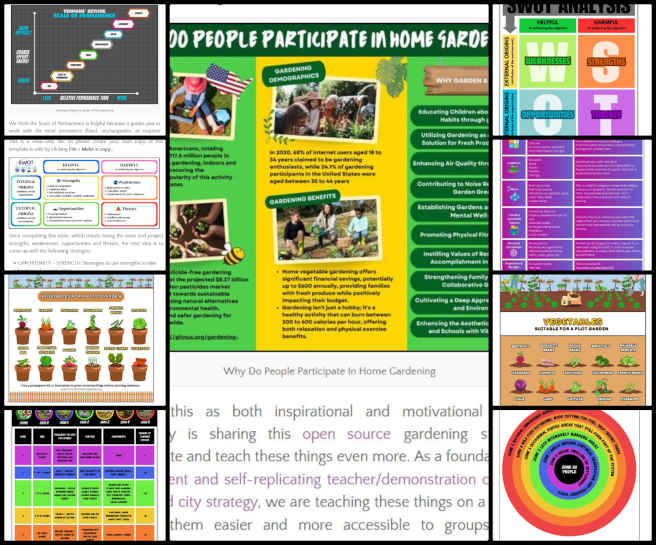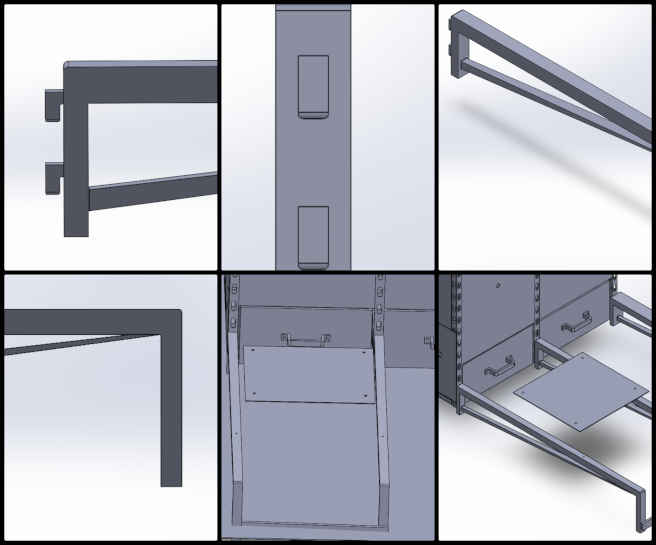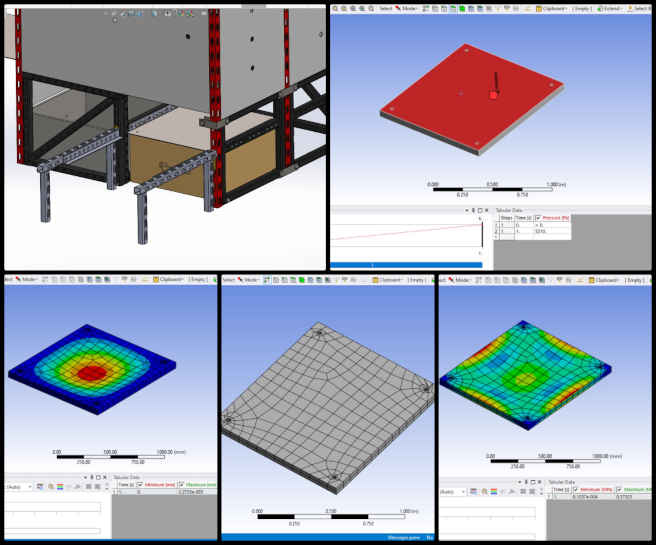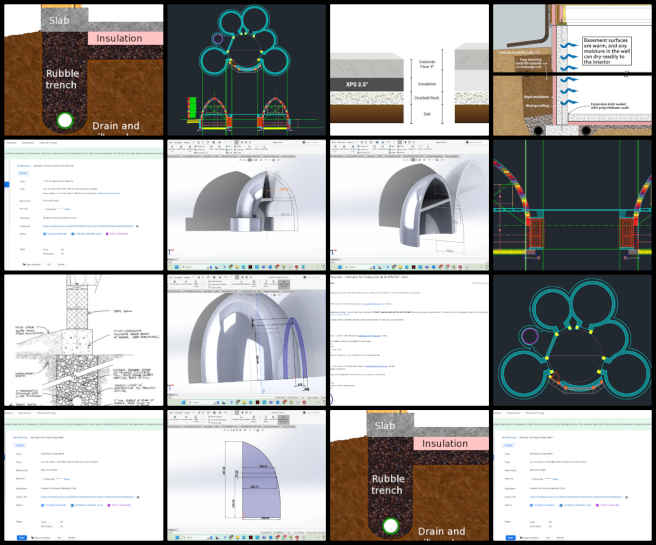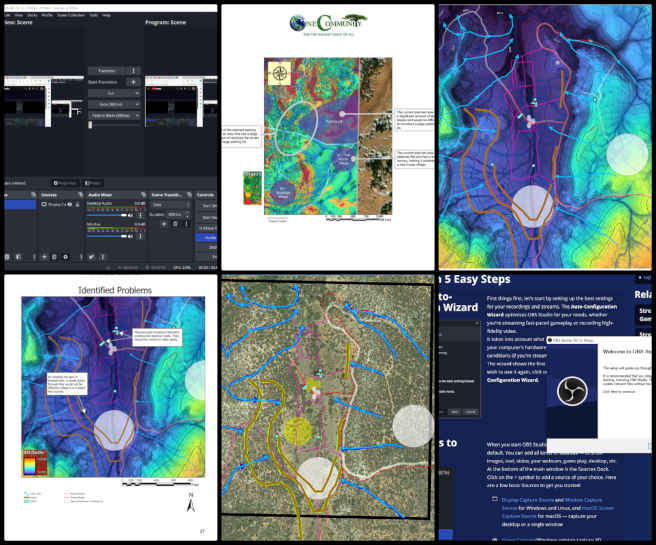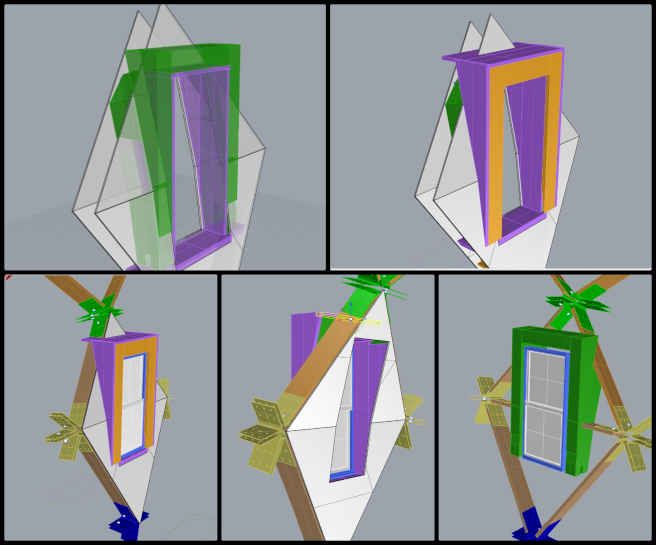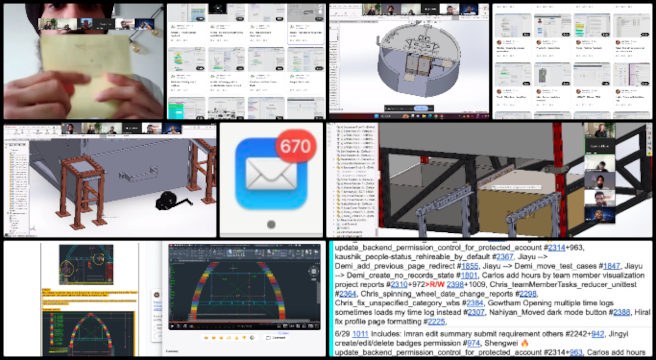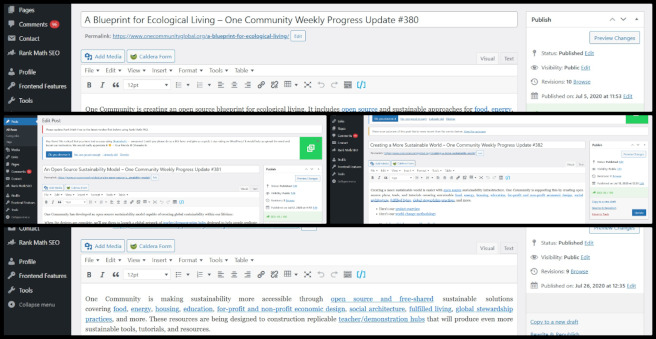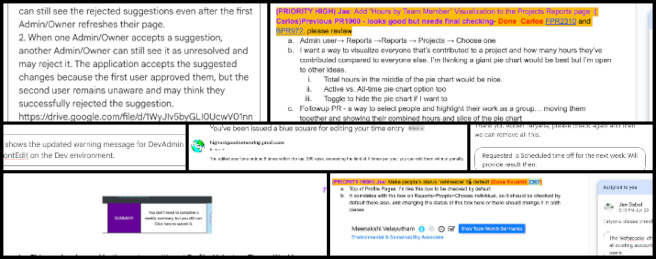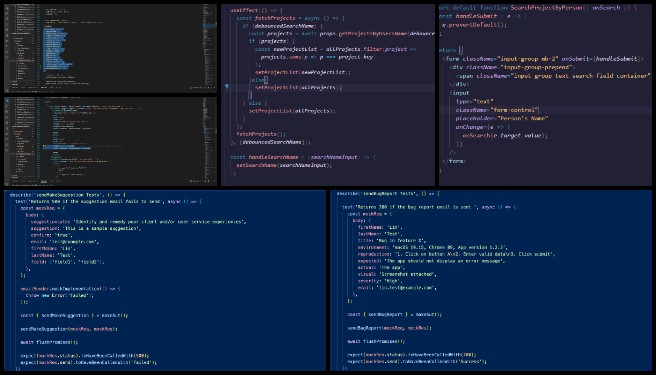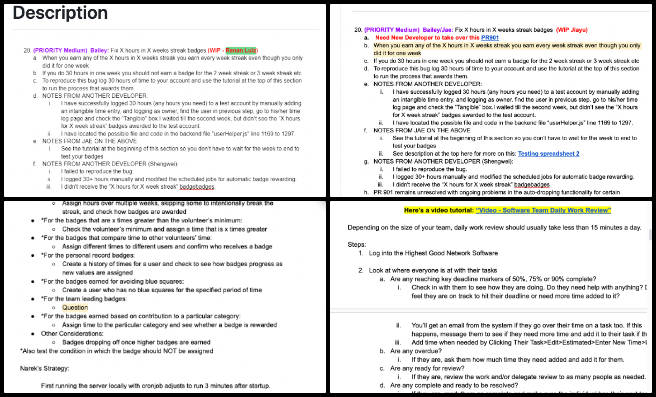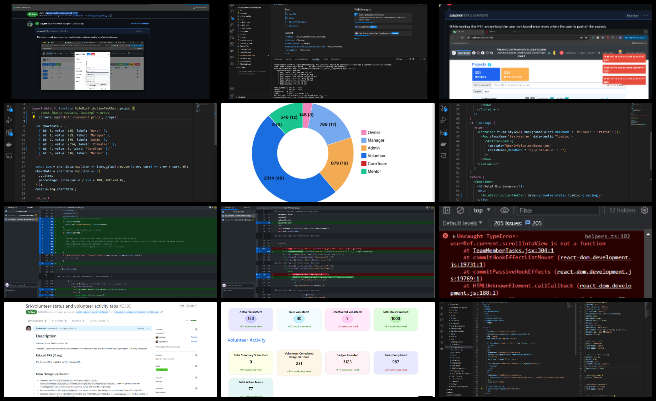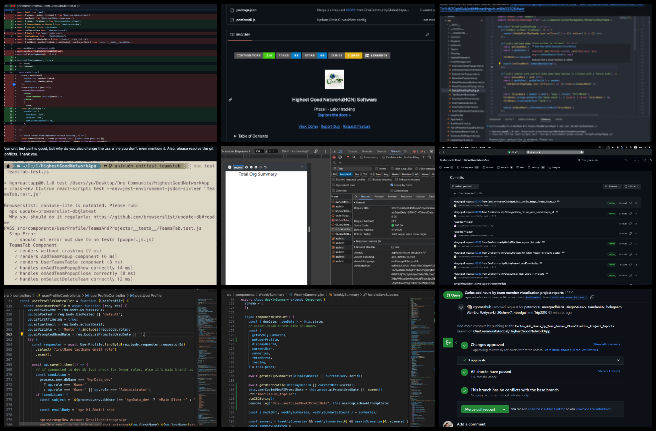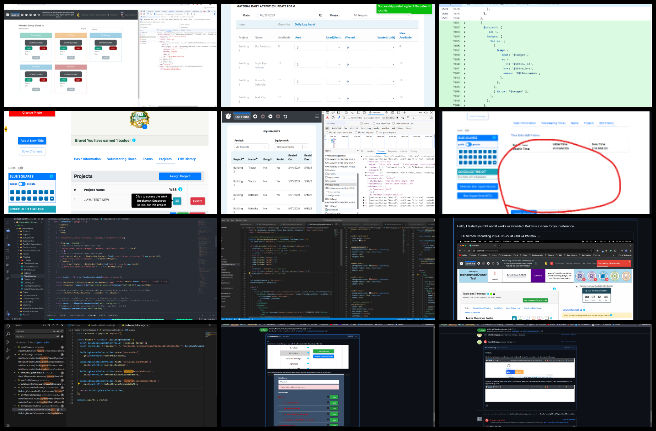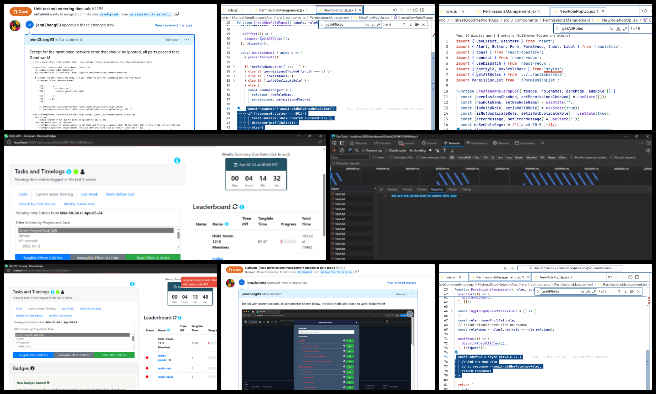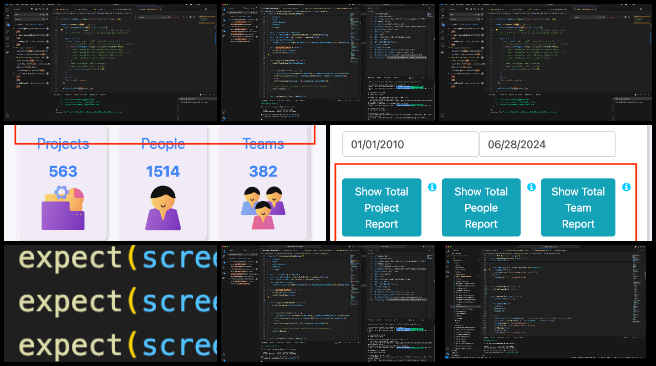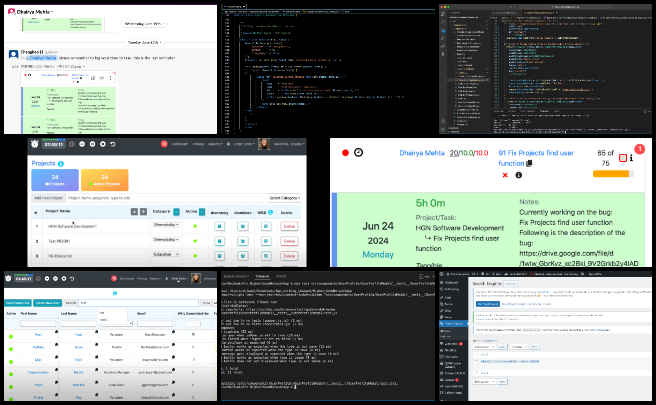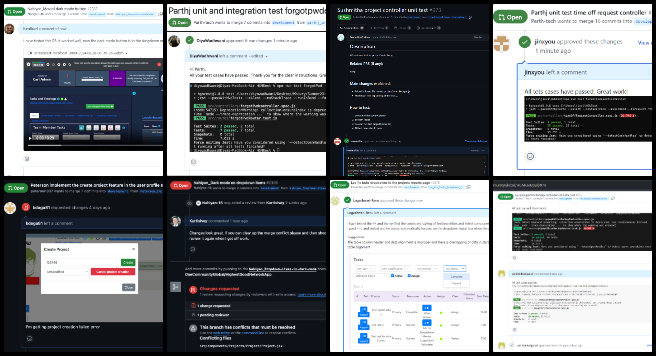Eco-cooperative Approach to World Change – One Community Weekly Progress Update #589
One Community is demonstrating an eco-cooperative approach to world change by construction of sustainable and self-replicating communities, villages, and cities around the world. It is open source and free-shared, includes 7 sustainable village models, food self-sufficiency plans, energy infrastructure, all-ages education, for-profit and non-profit economic options, social and recreational models, and more – all designed with a guiding philosophy and intent to live and create for “The Highest Good of All.”
- Here’s our project overview
- Here’s our world-change methodology
- Here’s how this becomes self-replicating
- Here’s how we are open source and free-sharing all the do-it-yourself designs
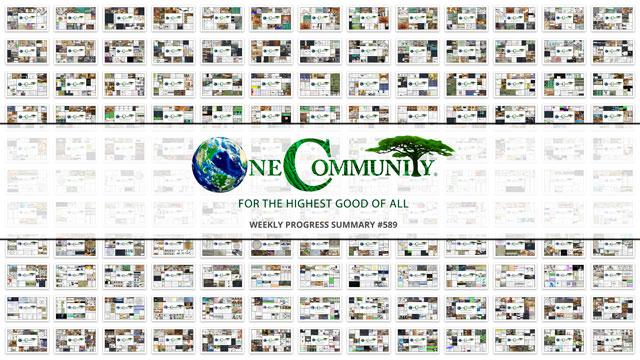
OUR MAIN OPEN SOURCE HUBS
Click on each icon to be taken to the corresponding Highest Good hub page.
One Community’s physical location will forward this eco-cooperative approach to world change as the first of many self-replicating teacher/demonstration communities, villages, and cities to be built around the world. This is the July 1st, 2024 edition (#589) of our weekly progress update detailing our team’s development and accomplishments:
Eco-cooperative Approach to World Change
One Community Progress Update #589
DONATE | COLLABORATE | HELP WITH LARGE-SCALE FUNDING
CLICK HERE IF YOU’D LIKE TO RECEIVE AN EMAIL EACH WEEK WHEN WE RELEASE A NEW UPDATE
YOU CAN ALSO JOIN US THROUGH SOCIAL MEDIA
ONE COMMUNITY WEEKLY UPDATE DETAILS
HIGHEST GOOD HOUSING PROGRESS
 One Community is demonstrating an eco-cooperative approach to world change through Highest Good housing that is artistic and beautiful, more affordable, more space efficient, lasts longer, DIY buildable, and constructed with healthy and sustainable materials:
One Community is demonstrating an eco-cooperative approach to world change through Highest Good housing that is artistic and beautiful, more affordable, more space efficient, lasts longer, DIY buildable, and constructed with healthy and sustainable materials:
- Learn about: Our Upcoming Crowdfunding Campaign
- Learn about the different village models of this eco-cooperative approach to world change: 7 Sustainable Village Models
- Visit the open source portals for the first two villages in this eco-cooperative approach to world change: Earthbag Village OS Hub | Straw Bale Village OS Hub
This week, Charles Gooley (Web Designer) focused on two pages: The Earthbag Village Tools and Equipmentent and Open Source DIY Earth Dam Design & Construction for Water Retention, Pond & Lake Creation. He replaced images on several pages: Large Scale Gardening, Open Source DIY Permaculture-Design, Most Sustainable Lightbulbs and Light Bulb Companies, and Consensus With Large Groups. The replaced images on the last page had links that may need updating. This work is now ready for review. Additionally, thirty-six placeholder images across recipe pages were replaced with images provided by the graphic designer. Earth constructions like both of these are an important part of an eco-cooperative approach to world change with One Community’s open source plans. See his work in the collage below.
Joseph Osayande (Mechanical Engineer) continued helping finish the Vermiculture Toilet designs. This week, his work focused on a new idea for the support system, which was modeled in SolidWorks and is still in its preliminary phase. A draft model was created for team critique, leading to further design changes. The conversion from whole blocks to unistrut pieces is being planned, including how to bolt them together for a structure that is only three inches in width, with bolting three struts together being a potential solution. Version 2 of the structure was made, with changed dimensions and aligned faces, and a stabilizer piece was modeled with 5/64-inch holes to keep the two support pieces stable. Future steps include researching hooks needed to latch onto the chamber’s vertical unistruts and determining how to attach the unistrut pieces. The vermiculture toilets and other sustainable human waste processing technologies form the basis of One Community’s open source model and eco-cooperative approach to world change. See below for some of the pictures related to this work.
Rizwan Syed (Mechanical Engineer) also continued helping finish the Vermiculture Toilet designs. This week, Rizwan focused on designing L-shaped corner brackets in SolidWorks to support the removable sliders of the vermiculture chamber system. His designs included a short corner bracket, intended for placement in sets of three at equal intervals, and a larger bracket spanning the entire length of the slider. Corresponding CAD modifications were made to the external unistrut structures to enhance slider operation above the chamber container. Additionally, he did a static structural analysis on the slider block using ANSYS FEA tools to assess deformation and stress distribution. Two loading scenarios were simulated: one with uniform load distribution and another with load concentrated in a small circular area at the plate’s center. Inputting dimension and material data into ANSYS, he calculated total deformation and maximum equivalent stress on the slider. Rizwan also provided a comprehensive update on the project’s progress over the past two months, outlining critical action items for future phases. The vermiculture toilets and other sustainable human waste processing technologies form the basis of One Community’s open source eco-cooperative approach to world change. Here are a few photos showing examples of his work.
AIRCRETE TEAM
The Aircrete Testing Team’s summary, covering their work on Aircrete Compression Testing was managed by John Sullivan (CBU Chemical Engineering Student) and includes Jonathan Crago (Civil Engineering Student), Preston Thompson (Civil Engineering Student), and Tad Matlock (Environmental Science Student). This week, Preston, Jonathan, and Tad each concentrated on their respective tasks related to aircrete research. Preston collaborated with the team to produce aircrete batches using various methods, including Aircrete Harry and Domegaia, encountering challenges with collapsing samples and issues during compression tests. Jonathan and his team focused on creating aircrete cylinders using the Domegaia method, experimenting with mix adjustments and curing techniques, but faced consistent failures with moist samples. Meanwhile, Tad did his part contributing to our eco-cooperative approach to world change as he worked on drafting and proofreading trial summaries for the Aircrete webpage, ensuring 20 trials were documented with necessary visuals. Additionally, he formulated an outline summarizing past team data, highlighting achievements and areas for improvement. John and the team focused on resolving the collapsing issue associated with the Domegaia method. They began utilizing a concrete mixer, which offered some improvement in consistency but continued to produce samples prone to collapse. John views the concrete mixer as a promising approach but acknowledges the need for further refinement to achieve consistent batches. Despite adjusting soap concentration, mixing time, method, and water-to-cement ratio, all attempts resulted in sample collapse. If the team cannot achieve reliability with the Domegaia method soon, John proposes shifting focus to Aircrete Harry and potentially discontinuing efforts with Domegaia altogether. These aircrete tests contribute to the housing aspect of One Community’s open source model as an eco-cooperative approach to world change. See below for some of the pictures related to this work.
EARTHBAG VILLAGE 4-DOME HOME TEAM
The Earthbag Village 4-dome Home Team was managed by Khushboo Parmar (Project Manager) and includes Michaela Silva (Architect), Adefola Madehin (Electrical Design Specialist), Yusuf Thanawala (Structural Engineer), and Karthik Pillai (Volunteer Mechanical Engineer). This week, Adefola reviewed electrical codes related to wiring and installations in Earthbag structures. His review covered guidelines for running electrical wires through Earthbag walls and floors, ensuring the safe and accessible placement of outlets and switches, and proper grounding and bonding techniques specific to Earthbag buildings. He also examined the installation requirements for electrical panels and procedures for inspections and testing to meet safety standards. Michaela finalized the proposed dome profile using specified diameter and Earthbag standards, revised the floor plan to accurately depict the junctions of all Earthbag walls, outlined the living space boundaries, synchronized the building section with the updated plan and dome profile, and laid out the open floor plan for the kitchen. On the 4-Dome Cluster Roof Design Team, Karthik did his part working towards this eco-cooperative approach to world change as he reviewed the Earth Dome Loft Structural Engineering and Calculations webpage to understand the project requirements and clarified his contributions in the weekly meeting. He continued working on creating a 3D layout of the four-dome cluster orientation, shared relevant screenshots and references to Dropbox, and plans to complete the 3D modeling within the next 2 to 3 weeks. Yusuf, also on the 4-Dome Cluster Roof Design Team, gained clarity on the 4-Dome cluster design following a meeting with his teammates, where the team decided to focus on the common loft first, with attic details to be finalized later. Yusuf also did his part working towards this eco-cooperative approach to world change as he began working on the STAAD.Pro analysis and reviewed the codal provisions for wood design using the AITC manual. Additionally, Khushboo prepared for and held the 4-Dome Cluster Roof meeting to support project progress. In the meeting, the team members introduced themselves, identified blockers that were hindering the project, and communicated these issues to Jae for support. The team also discussed their action plans for the next week to advance the project. Khushboo received confirmation for an interview, but the candidate did not attend. She continues to review the Work Breakdown Structure (WBS) for both teams to better understand the projects, their goals, and the organization. The Earthbag village forms the basis of One Community’s open source model for eco-cooperative approach to world change. See their work in the collage below.
DUPLICABLE CITY CENTER PROGRESS
 One Community is demonstrating an eco-cooperative approach to world change through a Duplicable and Sustainable City Center that is LEED Platinum certified/Sustainable, can feed 200 people at a time, provide laundry for over 300 people, is beautiful, spacious, and saves resources, money, and space:
One Community is demonstrating an eco-cooperative approach to world change through a Duplicable and Sustainable City Center that is LEED Platinum certified/Sustainable, can feed 200 people at a time, provide laundry for over 300 people, is beautiful, spacious, and saves resources, money, and space:
- Learn about this building and it’s function as part of our eco-cooperative approach to world change: Duplicable City Center Open Source Hub
This week, Chris Blair (GIS Technician/Horticulturist) continued working with GIS data as part of One Community’s Permaculture Design. He finished a Google document to showcase new village locations for the master plan, using Ben Missimer’s georeferenced maps. He digitized the water harvesting plan for the area around the Duplicable City Center and overlaid the results on another georeferenced map by Ben Missimer, identifying a few issues. Chris also completed Google document to present suggestions on moving the locations of swales and ponds. Additionally, he researched video recording software and chose to learn OBS (Open Broadcaster Software) to record future tutorials on using GIS tools for permaculture design. Proper property modeling and understanding is a foundational part of One Community’s open source eco-cooperative approach to world change model. Here are a few photos showing examples of his work.
Nika Gavran (Industrial Designer) continued her work on the Duplicable City Center dormer window installation plans. This week, Nika focused on moving forward with the dormer window assembly instructions, concentrating on increasing the rock wool insulation surrounding the dormer window. She adjusted the window design to accommodate more insulation on the exterior of the window frame, ensuring proper and sustainable insulation. The exterior layer is now thick enough to achieve an R30 insulation value. The Duplicable City Center is a foundational part of One Community’s open source eco-cooperative approach to world change. See below for some of the pictures related to this work.
HIGHEST GOOD FOOD PROGRESS
 One Community is demonstrating an eco-cooperative approach to world change through Highest Good food that is more diverse, more nutritious, locally grown and sustainable, and part of our open source botanical garden model to support and share bio-diversity:
One Community is demonstrating an eco-cooperative approach to world change through Highest Good food that is more diverse, more nutritious, locally grown and sustainable, and part of our open source botanical garden model to support and share bio-diversity:
- Learn about the structures we’ll build first as part of this eco-cooperative approach to world change: Hoop House Hub | Aquapini & Walipini Open Source Hub
- See what we’ll be growing first as part of this eco-cooperative approach to world change: Gardens & Hoop Houses | Large-scale Structures | Food Forest | TA
This week, the core team continued updating and expanding the Highest Good Food tools, equipment, materials, and supplies document by adding new items and breaking down the categorization of tools and equipment into powered and non-powered. They further separated some of these entities into new categories. Highest Good Food is an important part of an eco-cooperative approach to world change with One Community’s open source plans. See their work in the collage below.
HIGHEST GOOD EDUCATION PROGRESS
 One Community is demonstrating an eco-cooperative approach to world change through Highest Good education that is for all ages, applicable in any environment, adaptable to individual needs, far exceeds traditional education standards, and more fun for both the teachers and the students. This component of One Community is about 95% complete with only the Open Source School Licensing and Ultimate Classroom construction and assembly details remaining to be finished. With over 8 years of work invested in the process, the sections below are all complete until we move onto the property and continue the development and open sourcing process with teachers and students – a development process that is built directly into the structure of the education program and everything else we’re creating too:
One Community is demonstrating an eco-cooperative approach to world change through Highest Good education that is for all ages, applicable in any environment, adaptable to individual needs, far exceeds traditional education standards, and more fun for both the teachers and the students. This component of One Community is about 95% complete with only the Open Source School Licensing and Ultimate Classroom construction and assembly details remaining to be finished. With over 8 years of work invested in the process, the sections below are all complete until we move onto the property and continue the development and open sourcing process with teachers and students – a development process that is built directly into the structure of the education program and everything else we’re creating too:
- Eco-cooperative approach to world change education program overview: Education Open Source Hub
- How these components work together as part of our model for eco-cooperative approach to world change: How to use the Education for Life Program
- Lesson Plans for Life – Lesson Plans How-to
- Foundations of Outstanding Leaders, Teachers, and Communicators as part of an eco-cooperative approach to world change
- Curriculum for Life
- Teaching Strategies for Life
- Learning Tools and Toys for Life
- Evaluation and Evolution
This week, Brian Mwoyowatidi (Graduate Structural Engineer) continued helping with the engineering details for The Ultimate Classroom part of the Highest Good Education component. He learned and utilized STAAD Pro Foundations to model and analyze the isolated footings for the Ultimate Classroom. He worked on inputting relevant project information, column geometry and dimensions, creating load cases, adding column reactions and soil bearing capacity, incorporating self-weight, design parameters, and completing the analysis and design. His work, includes the AutoCAD detail drawing, AutoCAD GA drawing, schedule drawing, and detailed calculation report for the Ultimate Classroom tutorial and report, researching relevant references and building an outline. From this outline, Brian covered the project overview, objectives, summary of codes, compliance strategy, foundation design (particularly footers), and flooring design, including material selection, floor insulation, and installation process. The One Community model of combining forward-thinking education with sustainably built classrooms like this is an excellent example of an eco-cooperative approach to world change. See the collage below for his work.
HIGHEST GOOD SOCIETY PROGRESS
 One Community is demonstrating an eco-cooperative approach to world change through a Highest Good society approach to living that is founded on fulfilled living, the study of meeting human needs, Community, and making a difference in the world:
One Community is demonstrating an eco-cooperative approach to world change through a Highest Good society approach to living that is founded on fulfilled living, the study of meeting human needs, Community, and making a difference in the world:
- Read the Highest Good society overview: Highest Good Society
- Learn about the eco-cooperative approach to world change model for fulfilled living and sharing: A Day in the Life
- Learn about the 4 economic models as part of an eco-cooperative approach to world change: RBE | For-profit | Non-profit | Entrepreneurship
This week, the core team completed over 55 hours managing One Community’s volunteer-work review not included above, emails, social media accounts, web development, new bug identification and bug-fix integration for the Highest Good Network software, and interviewing and getting set up new volunteer team members. They also shot and incorporated the video above that talks about the eco-cooperative approach to world change and how an eco-cooperative approach to world change is a foundation of the bigger picture of everything One Community is doing. The picture below shows some of this work.
Arun Chandar Ganesan (Volunteer Data Analyst and SEO and Social Media Assistant) focused on improving webpage SEO, reviewing numerous pages, and working on over 20 blogs, including some previously abandoned ones. He also improved the scores of his previous web pages. Additionally, Arun managed and coordinated the scheduling of posts on One Community’s social media platforms such as Facebook, Instagram, Pinterest, and LinkedIn, and regularly updated the tutorials. This work helps One Community to broaden our reach in social media and spread our message about an eco-cooperative approach to world change. The following images show his work for the week.
ADMINISTRATION TEAM
The Administration Team’s summary, covering their work administrating and managing most of One Community’s ongoing process for an eco-cooperative approach to world change was managed by Sneka Vetriappan (Data Analyst) and includes Durgeshwari Naikwade (Data Analyst), Jessica Fairbanks (Administrative Assistant), Jim Zhang (Administrative Assistant), Kishan Sivakumar (Administative Assistant and Software Team Manager), Olawunmi “Ola” Ijisesan (Administrative and Management Support), Rachna Malav (Data Analyst), Ratna Meena Shivakumar (Data Analyst and Admin), Ruiqi Liu (Administrative Assistant), T R Samarth Urs (Data Analyst), Vibhav Chimatapu (Data Analyst/Admin Assistant) and Zuqi Li (Administrative Assistant and Economic Analyst). This week, Durgeshwari handled interviews and created a tracking table for Phase 3 deliverables. Jessica completed administrative tasks, improved food work structures, and guided a new admin team member. Jim caught up on updates, revised the electrical cost analysis for the Earthbag Village project, and worked on blog SEOs. Kishan did his part contributing to our eco-cooperative approach to world change as he reviewed and updated blog content and began aligning SEO pages with guidelines. Ola managed PR team performance reviews, scheduled Pinterest posts, resized images, and ensured proper documentation. Rachna handled regular tasks, provided team feedback, scheduled interviews, and addressed app downtime challenges. Ratna prepared summaries, collages, reviewed updates for food and core teams, and coordinated posts and blogs.
Ruiqi completed reviews for Dev Dynasty and Git-R-Done, assisted with admin tasks, informed members about bio publications, and updated the Light Bulb Company Benchmarking link. Sneka focused on SEO optimization and timelog management, revising older pages and improving timelog entries. Samarth did his part contributing to our eco-cooperative approach to world change as he evaluated the 16-member PR review team, summarized their work in an accepted blog post, and provided feedback. Vibhav also did his part working towards this eco-cooperative approach to world change as he reviewed PR team summaries, ensured PR submissions, created summaries and collages, and updated SEO-optimized webpages. Zuqi organized summaries for the Graphic Design and Alpha Teams, reviewed optimized blog pages, and provided feedback on new admins’ setup actions. One Community’s model for an eco-cooperative approach to world change includes developing and maintaining a supportive administration team like this. You can see the work for the team in the image below.
GRAPHIC DESIGN TEAM
The Graphic Design Team’s summary was managed by Zuqi Li (Administrative Assistant and Economic Analyst) and included Ashlesha Navale (Graphic Designer) and Jasmine Soria (Graphic Designer), covering their work on graphic designs for an eco-cooperative approach to world change. This week, Ashlesha worked on making changes to the Treehouse Village book on pages 36 to 39, uploading the InDesign book file and creating a PDF. She researched and curated a collection of nature-based and theme-based background images, creating six social media images. Jasmine did her part working towards this eco-cooperative approach to world change as she focused on a team member announcement, uploading it to WordPress, and made minor corrections to a previous announcement. She edited the image using Photoshop and modified the graphic in Illustrator. Additionally, she created a new social media graphic, ensuring the icons, images, texture, and text were formatted for readability and coherence. See the Highest Good Society pages for more on how this relates to an eco-cooperative approach to world change. See the collage below to view some of their work.
HIGHEST GOOD NETWORK PROGRESS
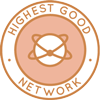 One Community is demonstrating an eco-cooperative approach to world change through open source Highest Good Network® software that is a web-based application for collaboration, time tracking, and objective data collection. The purpose of the Highest Good Network is to provide software for internal operations and external cooperation. It is being designed for global use in support of the different countries and communities replicating the One Community sustainable village models and related components.
One Community is demonstrating an eco-cooperative approach to world change through open source Highest Good Network® software that is a web-based application for collaboration, time tracking, and objective data collection. The purpose of the Highest Good Network is to provide software for internal operations and external cooperation. It is being designed for global use in support of the different countries and communities replicating the One Community sustainable village models and related components.
- Learn about our open source community collaboration and management software designed to measure and support our eco-cooperative approach to world change: The Highest Good Network
This week, the core team continued their work on the Highest Good Network PRs testing, confirming the fixed PRs. The PRs include editing the time entry tracking and the blue square function (PR2131), enhancing the protected account activity warning feature, and resolving a mentor summary setting issue (PR2317). Additional fixes include addressing a white screen issue in the Teams section and creating a way to reorder User Suggestion Categories (PR1913) on the Dev environment. They also identified issues that are yet to be fixed which include “Hours by Team Member” visualization on the Projects Reports page and setting user status to “rehireable” by default (2367). They also improved the admin/owner users’ ability to approve suggested task changes, tested related features, recorded explanatory videos, and set up a case for testing a new scheduled-on-date feature (FE2009/BE779). They further reviewed the Highest Good Network User’s Manual, updated images for the Dashboard menu bar, timer buttons, and theme options, and commented on the Profile page text. See the Highest Good Society and Highest Good Network pages for more on how this relates to an eco-cooperative approach to world change. The collage below shows some of their work.
ALPHA SOFTWARE DEVELOPMENT TEAM
The Alpha Team’s summary, covering their work on the Highest Good Network software was managed by Lin Khant Htel (Frontend Software Developer) and includes Anand Seshadri (Software Engineer) and Nathalia Carnevalli (Full Stack Software Developer). The Highest Good Network software is how we will manage and measure our processes for an eco-cooperative approach to world change across our social architecture, construction, production, and maintenance processes. This week, Lin performed unit testing for the DashboardController, focusing on the sendBugReport and sendMakeSuggestion functions, with all test cases passing. He also fixed test cases for the leaderboard data function, dashboard data function, and getOrg data function, and added the updated tests to his GitHub repository. Additionally, Lin did his part contributing to our eco-cooperative approach to world change as he reviewed the weekly summaries, photos, and videos of his team Alpha members.
Anand did his part working towards this eco-cooperative approach to world change as he worked on Dark Mode Modals changes in the Reports page and addressed several key tasks, including fixing a bug in the Add Task Modal where the error message for incorrect start and end dates was not cleared when the Reset button was clicked. He implemented a clear function to ensure date states were reset, and the dark mode field displayed the dates. Anand also worked on making the teams table responsive for mobile views below 576px, although the issue persists when minimizing the browser tab. Additionally, he reviewed PR 2366 to set the end date as per the final day. Nathalia focused on the task Search Project By Person, implementing debouncing to handle frontend requests. After completing the implementation, she retested her work, made minor adjustments, and submitted a pull request for both the frontend and backend repositories. Nathalia also reviewed several pull requests, PRs #2366, #2384, #2388, #2390, and #2382. See the Highest Good Society and Highest Good Network pages for more on how this relates to an eco-cooperative approach to world change. View some of the team’s work in the collage below.
BADGES BUGS SOFTWARE DEVELOPMENT TEAM
The Badges Bugs Team’s summary overseeing advancements in the Highest Good Network software was managed by Summit Kaushal (Backend Software Developer) The Highest Good Network software is how we’ll be managing and objectively measuring our process for an eco-cooperative approach to world change through our social architecture, construction, production, and maintenance processes. This week, Summit examined the code for PR 901, carefully reviewing both completed and pending tasks. He tested PR 901 by going over its description and requirements, verifying its functionality, and attempting to test the frontend. However, an error regarding connection refusal was encountered, which might be a local issue since no backend errors were noted, and further testing will be required. He also tried to review PR 996 but faced difficulties with Postman, where POST requests worked, but GET requests resulted in a 404 error despite everything appearing to match and following the debugging guide. Additionally, Summit reviewed management documents and spent some time revising a recruiting letter for the team. See the Highest Good Society and Highest Good Network pages for more on how this relates to an eco-cooperative approach to world change. View some of the team’s work in the collage below.
BINARY BRIGADE SOFTWARE DEVELOPMENT TEAM
The Binary Brigade Team’s summary overseeing advancements in the Highest Good Network software was managed by Min Sun (Software Engineer) and includes Aaryaneil Nimbalkar (Software Developer), Huijie Liu (Software Engineer), Peizhou Zhang (Software Engineer), Sandhya Adavikolanu (Software Developer) and Sri Sudersan Thopey Ganesh (Software Engineer). The Highest Good Network software is how we’ll be managing and objectively measuring our process for an eco-cooperative approach to world change through our social architecture, construction, production, and maintenance processes.
This week, Aaryaneil added test cases to the PieChartInfoDetail component for scenarios including rendering keyName and value, applying darkMode class, applying legend square color, rendering keyName and value with darkMode, rendering with specific margin styles, rendering with different color and darkMode combinations, and applying a special key class when keyName is “Special.” He also corrected errors in the unit tests for the LoginPrivileges component for tests involving calling handle input change, no role selected and multiple renders. He completed unit testing for both LoginPrivileges and PieChartInfoDetail, and created the corresponding pull requests. Aaryaneil also reviewed PRs #2403 on permissions management modals in dark mode, #2397 on improving loading resources list, #2396 on fixing UI for buttons and graph, and #2392 on adding a new filter for projects by user name. Huijie focused on developing the chart components for the new feature, Total Org Summary. She utilized Material UI to create the chart and set the sizing parameters correctly. She worked on connecting data from Redux states for the charts. Additionally, Huijie did her part contributing to our eco-cooperative approach to world change as she addressed updates for the fix time not match task by properly adding manually entered lost times to the timelog page. Min worked on adding manager icons on the team tasks page, formatted the icons, checked for bugs, and prepared the work for review. He reviewed teammates’ previous week summaries, time logs, photos, and videos, providing feedback on their work and completing all managerial tasks. Min scheduled the weekly meeting with the team and answered queries on claiming and starting tasks. Peizhou worked on the refresh efficiency issue. He programmed the system to remember the last edited user’s ID and passed this ID from one component to its child using ref. He then checked if the user ID of the corresponding child component matched the last edited user’s ID, and if so, marked it. Finally, Peizhou attempted to scroll to that component’s position after re-rendering.
Sandhya focused on the intricate task of developing the PDF component for the Weekly Volunteer Summary within the HGN Software Development project. She worked on troubleshooting runtime errors and addressing issues like “ReferenceError: process is not defined” and missing module errors for PieChartByProject and WbsPiechart due to missing ‘recharts’. During this period, she also participated in a meeting with Harsh to discuss progress and the issues she was encountering. Sandhya’s work included creating the PDFDocument.jsx to define the structure and content of the PDF and developing ShareAsPDFButton.jsx to handle the functionality for downloading the PDF using html2canvas and jsPDF. The process included pulling updates, merging branches, and resolving conflicts, all while ensuring that the new code did not disrupt existing functionality in other components like TeamReport.jsx. The week also involved a deep dive into the codebase, fixing various errors, and ensuring the new PDF component followed the structure of totalOrgSummary. Sri did his part contributing to our eco-cooperative approach to world change as he joined the development team working on the weekly-volunteer-summary-dashboard branch and created Pull Request #2395 titled “Sri/volunteer status and volunteer activity tabs.” He introduced a custom and responsive component namedStatisticsTab.jsx for displaying Volunteer Status and Activity tabs in the Total Organization Summary Dashboard. The main changes include receiving props such as title, number, percentageChange, type, isIncreased, tabBackgroundColor, and shapeBackgroundColor from the parent container TotalOrgSummary.jsx to dynamically render the components. Additionally, Sri implemented styles from a Vanilla CSS file,StatisticsTab.css, defining colors and designs specific to the Volunteer Status & Activity Tab. He also created two constant arrays, VOLUNTEER_STATUS_TAB and VOLUNTEER_ACTIVITIES_TABin totalOrgSummary.js to manage all volunteer status and activity information. See the Highest Good Society and Highest Good Network pages for more on how this relates to an eco-cooperative approach to world change. View some of the team’s work in the collage below.
BLUE STEEL SOFTWARE DEVELOPMENT TEAM
The Blue Steel Team’s summary, presenting their work on the Highest Good Network software was managed by Jingyi Jia (Software Engineer, Team Manager), and includes Bhuvan Dama (Full stack Developer), Jay Srinivasan (Software Engineer), Parth Rasu Jangid (Software Developer), Ramakrishna Aruva (Software Engineer), and Tzu Ning “Leo” Chueh (Software Engineer). The Highest Good Network software is how we’ll be managing and objectively measuring our process for developing an eco-cooperative approach to world change through our social architecture, construction, production, and maintenance processes. This week, Jay resumed his manager-in-training duties, reviewed weekly summaries, and media folders for Team Blue Steel. He addressed feedback on a previously opened mobile header UI pull request by fixing issues with navigation items overlapping and adjusting spacing for the expanded navigation bar on smaller viewports. Jay also enhanced security measures for account creation by integrating bcrypt comparison into the HGNRest application and implementing frontend changes to display related feedback to users. He created new branches for these updates and documented his work for the weekly summary. Bhuvan did his part working towards this eco-cooperative approach to world change as he focused on improving code coverage for the TableFilter.jsx file in the HGN Software Development project. He worked on enhancing coverage, achieving progress towards a 100% goal, and writing additional test cases aimed at exceeding 90% coverage, though some tests still failed.
Jingyi reviewed nine high-priority pull requests affecting various system aspects, PRs #2385, #2386, #2387, #2388, #2390, #2391, #2376, #2384, and #2386. Additionally, she identified a task to address a memory leak on the userProfile page linked to the blue squares segment, planning a refactor of useEffects and related functions to resolve the issue and optimize performance. Parth reviewed Pull Requests #2387, #2391, and #970+2306, focusing on covering all test cases for the timeOffRequestController and improving code readability through modularization. He also collaborated with another developer to resolve testing errors. Tzu Ning did his part contributing to our eco-cooperative approach to world change as he updated the TeamsTab component to ensure seamless interaction with backend services through axios for fetching, saving, and deleting team data, specifically making the UserTeamsTable component’s onSaveTeams function robust and reliable. Ramakrishna completed work on the hotfix related to team code changes, tested his changes, and raised pull requests (#2401 and #1010). He began addressing issues with capturing all user IDs related to team codes, working towards a solution. He utilized filter and map functions on summaries to collect all user IDs based on the selected team code. See the Highest Good Society and the Highest Good Network pages to learn more on how their work contributes to forming an eco-cooperative approach to world change. See below to view their work.
CODE CRAFTERS SOFTWARE DEVELOPMENT TEAM
The Code Crafters Team’s summary, covering their work on the Highest Good Network software, was managed by Anirudh Ghildiyal (Software Engineer) and includes Carlos Gomez (Full-stack Software Developer), Weiyao Li (Software Engineer) and Xiaoyu Chen (Software Engineer). The Highest Good Network software is how we’ll manage and objectively measure our process for exploring an eco-cooperative approach to world change through our social architecture, construction, production, and maintenance processes. Carlos addressed issues with changes in the weekly-summary-dashboard team as per Jae’s request, renaming “Weekly Volunteer Summary” to “Total Org Summary.” He fixed bugs related to API calls on the new /totalorgsummary page, including refactoring and testing TotalOrgSummary.jsx and TOTAL_ORG_SUMMARY in URL.js. Carlos also resolved merge conflicts in HGNRest/pull/972, enabling Jae to merge HGNRest/pull/972 and HighestGoodNetworkApp/pull/2310 into the Development branch. He merged the development branch into weekly-volunteer-summary-dashboard and the backend branch to fix file conflicts.
Xiaoyu attempted to write a mock findByID for a router test and began work on the volunteer weekly summary dashboard. She reviewed bug documentation, selected a new task involving a delete button, and noted inappropriate use of an information icon in permission management. She chose to work on an AI prompt bug, leading to modifications in the userProfile Controller and schema, transforming the value of aiPromptUsedDate from the weekly summary component to the prompt modal. Weiyao did his part contributing to our eco-cooperative approach to world change as he worked on the “add roles” feature, which required edit access to create roles with permissions. He finished alignment with Jae and continued work on the feature, also learning React, Redux, and testing concepts essential for future tasks. Anirudh fixed the merge conflicts for the SetupFinalDayPopUp and the TimeLogNavbar, preparing both for final merging and re-review. Additionally, he resolved the merge conflict for the TeamsTab and made the necessary changes based on feedback from Kurtis, sending it for re-review. See the Highest Good Society and Highest Good Network pages for more on how this relates to an eco-cooperative approach to world change. The collage below shows some of this work.
DEV DYNASTY SOFTWARE DEVELOPMENT TEAM
The Dev Dynasty Team’s summary, covering their work on the Highest Good Network software, was managed by Ruiqi Liu (Administrative Assistant) and includes Akshit Sharma (Software Engineer), Nahiyan Ahmed (Full Stack Software Developer), Harsh Bodgal (Software Engineer). and Jatin Agrawal (Software Engineer). The Highest Good Network software is how we’ll manage and objectively measure our process for exploring the eco-cooperative approach to world change through our social architecture, construction, production, and maintenance processes. Akshit added responsiveness to a previously identified bug in PR #2309. Additionally, he fixed the final-day functionality issue related to date formatting during the saving process, resulting in the creation of PR #2390 with changes in the several files. Jatin did his part contributing to our eco-cooperative approach to world change as he worked on 13 pull requests in the frontend repository. He also attempted to resolve a bug related to “Fix New people not showing in resources to add tasks” but couldn’t resolve it and notified Jae, resulting in the task being removed from his account.
Harsh did his part working towards this eco-cooperative approach to world change as he resolved conflicts in the backend and frontend branches for the weekly-volunteer-summary-dashboard, coordinated with the team to progress work, and assisted teammates during calls to address local issues and progress work. He began developing an accordion component as a wrapper class component for TotalOrgSummary. Nahiyan continued making progress with the mobile optimization of the dashboard component, publishing PR 2391, which enhanced the dashboard page’s compatibility with mobile and tablet displays by adjusting component widths and making font sizes more responsive. After publishing the PR, he addressed additional requested changes. Additionally, he published PR 2403, which fixed the permissions management modals in dark mode, and concluded the week by listing more bugs and feature requests for other pages to improve their mobile friendliness. See the Highest Good Society and Highest Good Network pages for more on how this relates to the eco-cooperative approach to world change. The collage below shows some of this work.
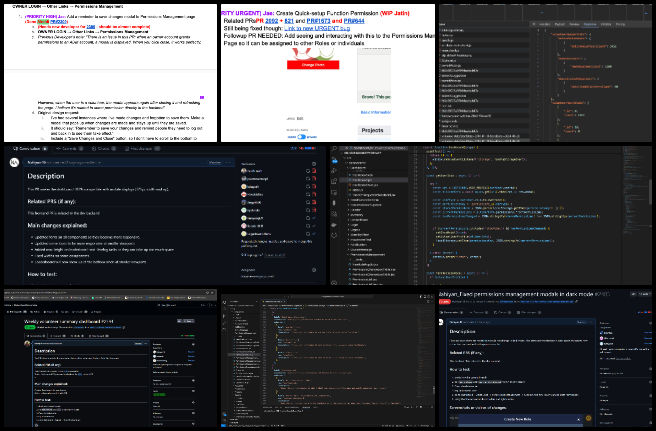
EXPRESSERS SOFTWARE DEVELOPMENT TEAM
The Expressers Team’s summary, covering their work on the Highest Good Network software, was managed by Shereen Punnassery (Full Stack Software Engineer) and includes KyoSook Shin (Software Engineer). The Highest Good Network software is how we’ll manage and objectively measure our process for exploring the eco-cooperative approach to world change through our social architecture, construction, production, and maintenance processes. This week, KyoSook completed front-end tasks including displaying members’ first and last names on the timelog page, implementing BMTimeLogDisplayMember.jsx to show each member’s name, adding a timelog card for members, differentiating card colors according to members’ roles, organizing timelog card items, cleaning up unused code, improving member card appearance to match the wireframe, and using !important to set button colors. On the backend, KyoSook fetched member roles to display member cards according to their roles.
Shereen worked on the reusable bulk update component, creating backend routing for the component, fixing issues related to the API call, and creating a controller function to update the bulk reusables. She also pushed the updates to GitHub and created a pull request. Mohammad did his part contributing to our eco-cooperative approach to world change as he completed two PR reviews, addressed the hour time delay task to resolve issues and improve the project’s functionality, and fixed an error in his own PR to ensure his contributions met the project’s standards. Jiayu modified the removePrevHrBadge function to repopulate newly added badge collections, updated the deletion condition to match the badge hours, tested the function with specific hour cases, adjusted the badge assignment order, added WBS access to the profile page projects with mouseover text, created a pull request for this feature, and expanded test cases for the streak auto dropoff pull request.
Kaushik completed six PR reviews, with some being approved and others requiring changes, reviewed the BMS dashboard component documentation, tested the application, and identified a bug in the permissions management page. See the Highest Good Society and Highest Good Network pages for more on how this relates to an eco-cooperative approach to world change. See the collage below for the team’s work this week.
GIT-R-DONE SOFTWARE DEVELOPMENT TEAM
The Git-R-Done Team’s summary, covering their work on the Highest Good Network software includes Chris Chen (Software Engineer Intern), Malav Patel (Software Developer) and Youyou Zhang (Software Developer). The Highest Good Network software is how we’ll be managing and objectively measuring our process for an eco-cooperative approach to world change across our social architecture, construction, production, and maintenance processes. This week, Chris made the pull request for fixing an unspecified category for wbs for pr #2384. Instead of returning the project itself for the default category, he now returns the project category, defaulting to ‘Unspecified’ if no category is found. These changes improve task categorization logic and are checked into the development branch.
Malav did his part contributing to our eco-cooperative approach to world change as he worked on fixing a bug in the DELETE_TIME_ENTRY_OTHERS feature and HGN software development. He made additional changes to restrict the permission of volunteers to delete owners/admins/Managers Time Entry Log into the code and pushed the changes into his own branch. He solved many issues that arose during the bug-fixing phase. Malav needed some assistance and communicated with Jae regarding this bug, aiming to fix some errors before raising a PR. He is also working on an efficiency task to determine where in HGN performance needs improvement.
Youyou completed the task of ensuring that newly added roles show up in the database and appear in the role list without requiring a manual refresh. She handled the onClick event response to display the correct toast message. Additionally, she approved PR 2355, which involved a unit test for the VolunteeringTimeTab component, noting one console error that was unrelated to the test itself. Youyou also approved PR 2390, which fixed a bug where the final date set for a user showed up as one day ahead of the desired date; she confirmed that all new features worked as expected when tested with an owner account. Following that, she approved PR 2402, which added WBS access from the user profile page, and verified its functionality with an admin account. Lastly, Youyou approved PR 2403, which introduced a dark view mode for the permission management page, confirming that it worked correctly when tested locally. See the Highest Good Society and Highest Good Network pages for more on how this relates to an eco-cooperative approach to world change. See the collage below for the team’s work this week.
MOONFALL SOFTWARE DEVELOPMENT TEAM
The Moonfall Team’s summary, covering their work on the Highest Good Network software was managed by Lu Wang (Software Engineer) and includes Abdelmounaim “Abdel” Lallouache (Software Developer), Jiadong Zhang (Volunteer Software Engineer), Shrada Chellasamiand (Software Engineer) and Yili Sun (Software Engineer). The Highest Good Network software is how we’ll be managing and objectively measuring our process for an eco-cooperative approach to world change across our social architecture, construction, production, and maintenance processes. This week, Abdelmounaim addressed an edge case involving the blue square feature, diagnosing an issue where inactive users not logging time for over a week were not receiving blue squares. He traced the problem to Shengwei’s code, which prevented new users from receiving blue squares. Abdelmounaim identified the root cause, implemented corrective measures, and tested the solutions to ensure proper functionality.
Lu did her part contributing to our eco-cooperative approach to world change as she focused on rewriting the code and fixing bugs in the unit tests for `PeopleReport/components/PeopleTasksPieChart.jsx` and `PeopleReport/selectors.js`. During the testing phase, she refactored the selector functions to ensure accurate filtering and processing of data according to updated requirements. Lu also enhanced the performance and visual accuracy of chart functions within the `PeopleTasksPieChart` component, addressing rendering issues and improving data binding. She rewrote test cases to cover edge scenarios and expand test coverage, debugging issues related to state management and asynchronous data handling. In addition to her technical responsibilities, Lu managed assistant team duties, including compiling the weekly report, doing good reviews of teammates’ work, and curating exemplary work images.
Jiadong did his part contributing to our eco-cooperative approach to world change as he worked on updating the dashboard’s badge system, uncovering and addressing multiple bugs in the backend badge routers and controllers. His refactorization efforts aimed to streamline system operations for improved efficiency, with ongoing refinements planned.
Shrada worked on resolving UI issues within the Reports feature across various screen sizes. Her optimizations included adjusting button layouts to ensure proper display between 1100px and 1350px width, refining top margins for Projects/People/Teams tables on screens below 1350px, and fixing issues with the project/people/team report graph visibility on screens smaller than 550px.
Yili resolved the Permissions Management info icons issue in Owner > Other Links > Permissions Management. The icons, situated beside save and delete buttons, previously failed to open pop-ups, rendering the UI unresponsive upon interaction. Even using the browser back button did not resolve the issue, instead redirecting users to the dashboard upon browser reload. Yili also identified discrepancies in the pop-up information and slated for correction. See the Highest Good Society and Highest Good Network pages for more on how this relates to an eco-cooperative approach to world change. See the collage below for the team’s work this week.
REACTONAUTS SOFTWARE DEVELOPMENT TEAM
The Reactonauts Team’s summary, covering their work on the Highest Good Network software was managed by Changhao Li (Software Engineer) and includes Dhairya Mehta (Software Engineer), Hetvi Patel (Software Engineer), Hoang Pham (Software Developer), Peterson Rodrigues dos Santos (Full-Stack MERN Stack Developer), Shiwani Rajagopalan (Software Engineer) and Vijeth Venkatesha (Full Stack Developer). The Highest Good Network software is how we’ll be managing and objectively measuring our process for an eco-cooperative approach to world change across our social architecture, construction, production, and maintenance processes. This week, Changhao worked on unit test development for `timeentry.jsx`, managed the software development team, and assisted the team with development-related issues. He resolved several issues but identified some edge cases requiring more time and plans to request extended hours to address these. Changhao also hosted the weekly team meeting, created the weekly team folder for uploading photos and videos, monitored time logs and task progress, and addressed an issue where a team member incorrectly logged time to the wrong task three times by sending a reminder via Slack.
Dhairya focused on addressing the “Fix Projects find user function” task, identifying the root cause of the issue affecting user discovery within the projects section, and developing a sort and search function to optimize user assignment processes.
Hetvi worked on meta fields, resolved a few bugs causing loading issues after creating the taxonomy, continued working on back-end data flow, testing, and resolving remaining bugs. She completed the development of meta fields and the backend page, worked on the front-end structure of the search engine by creating shortcodes, resolved backend bugs, created a live link for her local site, developed the form and filter for the search engine, and worked on the AJAX functionality to filter search engine results as her contribution to our eco-cooperative approach to world change.
Hoang did his part contributing to our eco-cooperative approach to world change as he focused on fixing a bug in the suggested task changes page, ensuring task changes are only approved or rejected once, regardless of how many users with appropriate permissions attempt to process them, and prepared a pull request to enhance the system’s task change functionality.
Peterson fixed two bugs on the “User Profile” page in the modal for assigning users to a team in the “Teams” tab, including creating the team and adding the user automatically after clicking the “Create Team” suggestion from the autocomplete, and adding a button to create the team with a warning if the team does not exist.
Shiwani did her part contributing to our eco-cooperative approach to world change as she worked on the UserProfileModal unit test, adding nine test cases, including rendering without crashing, checking if the modal opens and closes correctly, verifying the modal title, ensuring the Cancel and Close buttons work as expected, confirming the modal message displays correctly, and checking the Resize button’s functionality and presence based on the type. She created a mock redux store and used it to test these cases, continuing to add more test cases with plans to complete the unit test and raise a PR next week.
Vijeth encountered issues with JWT decoding, reached out to several developers for assistance, worked on pull request 2396, discussed implementing Docker in the project with Jae, received approval, and began researching Docker concepts, exploring Docker Desktop and Docker images to understand their integration into the project effectively. See the Highest Good Society and Highest Good Network pages for more on how this relates to an eco-cooperative approach to world change. See the collage below for the team’s work this week.
SKYE SOFTWARE DEVELOPMENT TEAM
The Skye Team’s summary, covering their work on the Highest Good Network software was managed by Luis Arevalo (Software Engineer) and includes Abi Liu (Software Engineer), Gowtham Dongari (Software Engineer), Kyrene Flores (Software Engineer), and Mengtian Chen (Software Engineer). The Highest Good Network software is how we’ll be managing and objectively measuring our process for eco-cooperative approach to world change across our social architecture, construction, production, and maintenance processes. This week, Abi worked on troubleshooting issues related to the backend pull request, researching and debugging to understand why some database queries were returning empty arrays. Additionally, he added queries to retrieve necessary data for the overview reports page, including total active teams, total badges awarded, and anniversary statistics.
Gowtham made progress on the “Fix ‘Filter by Over Hours'” task within the HGN Software Development project by integrating total tangible hours with weekly hours, setting up a filtering mechanism based on weekly committed hours, and developing a feature to assign badges for contributions exceeding 25% of committed hours. By the end of the week, he refined the filtering process to exclude entries from individuals with zero hours and filter out hours that were 25% above the committed hours, enhancing the system’s capability to manage and display over-hour data as his contribution to our eco-cooperative approach to world change.
Kyrene resolved a bug by removing the dead space on the user profile page, dealing with complications from a permission button exclusive to the Owner account. After submitting the fix, she received requests on GitHub for additional button margins and color changes, adding the margins but identifying that color changes were an application-wide issue. She assisted a cohort mate in resolving a bug related to a new route not connecting to the backend by suggesting a date format revision, which resolved the problem. She then began a new task to add margin to a table but encountered a backend bug in the dist folder, requiring further investigation.
Luis did his part contributing to our eco-cooperative approach to world change as he started unit testing the inventoryController, beginning from scratch to ensure solid understanding. He faced issues testing the getAllInvInProjectWBS function, which returned undefined or timed out, but implemented the unit test after researching solutions. He then tested postInvInProjectWBS to double-check his previous work, planning to complete the test by the end of the week.
Mengtian completed a Jest unit test for the NotificationCard component and created a new pull request for a unit test for GoogleDocIcon.jsx, ensuring the accuracy and functionality of the components. Any issues identified during testing were documented and addressed. See the Highest Good Society and Highest Good Network pages for more on how this relates to an eco-cooperative approach to world change. See the collage below for the team’s work this week.
SOFTWARE PR REVIEW TEAM A-L
The PR Review Team’s summaries for team members’ names starting with A-L and covering their work on the Highest Good Network software was managed by Vibhav Chimatapu (Data Analyst/Admin Assistant). The Highest Good Network software is a foundation of what we’ll be using to measure our results for an eco-cooperative approach to world change. This week’s active members of this team were: Carl Bebli (Software Engineer), Deepthi Kannan (Software Engineer), Diya Wadhwani (Software Developer), Howie Miao (Software Engineer/Developer), Ichinnorov Tuguldur (Software Engineer), Jinxiong You (Software Engineer), Keshav Daga (Software Engineer), Kurtis Ivey (Software Engineer), Sahithi Dhulipala (Software Engineer) and Logeshwari Renu (Software Engineer). They reviewed all the Highest Good Network PRs (Pull Requests) shared in this week’s update. Learn more about how the Highest Good Network will measure and assist in developing an eco-cooperative approach to world change in the Highest Good Network open source hub. The collage below shows a compilation of the work from this team.
SOFTWARE PR REVIEW TEAM M-Z
The PR Review Team’s summary for team members’ names starting with M-Z and covering their work on the Highest Good Network software was managed by Olawunmi “Ola” Ijisesan (Administrative and Management Support), and Samarth Urs (Administrative Assistant and Data Analyst). The Highest Good Network software is a foundation of what we’ll be using to measure our results of an eco-cooperative approach to world change. This week’s active members of this team were: Pavan Swaroop Lebakula (Software Engineer), Rishitha Kondabolu (Software Developer), Rohith Gummadi (Software Engineer), Sai Sarath Kumar Alavakonda (Software Engineer), Sarojni Tripathi (Fullstack Web Application Developer), Tianyang Leng (Software Engineer), Xiao Wang (Software Engineer), Vishavdeep Kaur (Full Stack Developer), Yash Agrawal (Software Engineer), Yiyun Tan (Software Engineer), and Zijie Yu (Software Engineer). They reviewed all the Highest Good Network PRs (Pull Requests) shared in this week’s update. Learn more about how the Highest Good Network will measure and assist in an eco-cooperative approach to world change in the Highest Good Network open source hub. The collage below shows a compilation of the work from this team.
AND WE PRODUCED THIS WEEKLY UPDATES BLOG – CLICK HERE TO SUBSCRIBE
FOLLOW ONE COMMUNITY’S PROGRESS (click icons for our pages)
INVESTOR PAGES
GET INVOLVED
DONATE | WAYS ANYONE CAN HELP | MEMBERSHIP
CLICK HERE FOR ALL PAST UPDATES
 One Community
One Community


